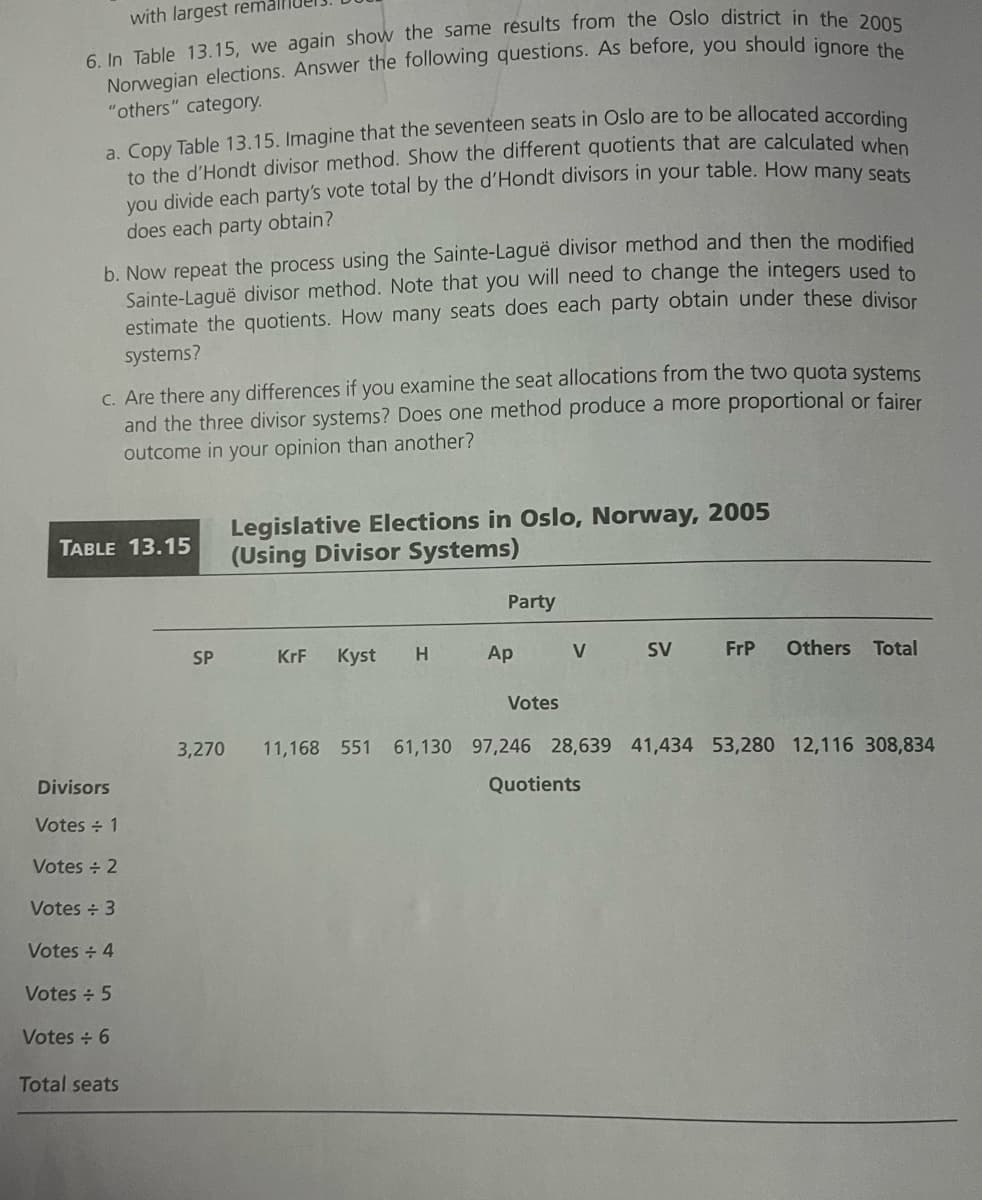with largest remall 6. In Table 13.15, we again show the same results from the Oslo district in the 2005 Norwegian elections. Answer the following questions. As before, you should ignore the "others" category. a. Copy Table 13.15. Imagine that the seventeen seats in Oslo are to be allocated according to the d'Hondt divisor method. Show the different quotients that are calculated when you divide each party's vote total by the d'Hondt divisors in your table. How many seats does each party obtain? b. Now repeat the process using the Sainte-Laguë divisor method and then the modified Sainte-Laguë divisor method. Note that you will need to change the integers used to estimate the quotients. How many seats does each party obtain under these divisor systems? c. Are there any differences if you examine the seat allocations from the two quota systems and the three divisor systems? Does one method produce a more proportional or fairer outcome in your opinion than another? TABLE 13.15 Legislative Elections in Oslo, Norway, 2005 (Using Divisor Systems) Divisors Votes ÷ 1 Votes ÷ 2 Votes÷3 Votes÷4 Votes ÷ 5 Votes÷6 Total seats Party SP KrF Kyst H Ap V SV FrP Others Total Votes 3,270 11,168 551 61,130 97,246 28,639 41,434 53,280 12,116 308,834 Quotients
with largest remall 6. In Table 13.15, we again show the same results from the Oslo district in the 2005 Norwegian elections. Answer the following questions. As before, you should ignore the "others" category. a. Copy Table 13.15. Imagine that the seventeen seats in Oslo are to be allocated according to the d'Hondt divisor method. Show the different quotients that are calculated when you divide each party's vote total by the d'Hondt divisors in your table. How many seats does each party obtain? b. Now repeat the process using the Sainte-Laguë divisor method and then the modified Sainte-Laguë divisor method. Note that you will need to change the integers used to estimate the quotients. How many seats does each party obtain under these divisor systems? c. Are there any differences if you examine the seat allocations from the two quota systems and the three divisor systems? Does one method produce a more proportional or fairer outcome in your opinion than another? TABLE 13.15 Legislative Elections in Oslo, Norway, 2005 (Using Divisor Systems) Divisors Votes ÷ 1 Votes ÷ 2 Votes÷3 Votes÷4 Votes ÷ 5 Votes÷6 Total seats Party SP KrF Kyst H Ap V SV FrP Others Total Votes 3,270 11,168 551 61,130 97,246 28,639 41,434 53,280 12,116 308,834 Quotients
Principles of Microeconomics (MindTap Course List)
8th Edition
ISBN:9781305971493
Author:N. Gregory Mankiw
Publisher:N. Gregory Mankiw
Chapter22: Frontiers Of Microeconomics
Section: Chapter Questions
Problem 7PA
Related questions
Question

Transcribed Image Text:with largest remall
6. In Table 13.15, we again show the same results from the Oslo district in the 2005
Norwegian elections. Answer the following questions. As before, you should ignore the
"others" category.
a. Copy Table 13.15. Imagine that the seventeen seats in Oslo are to be allocated according
to the d'Hondt divisor method. Show the different quotients that are calculated when
you divide each party's vote total by the d'Hondt divisors in your table. How many seats
does each party obtain?
b. Now repeat the process using the Sainte-Laguë divisor method and then the modified
Sainte-Laguë divisor method. Note that you will need to change the integers used to
estimate the quotients. How many seats does each party obtain under these divisor
systems?
c. Are there any differences if you examine the seat allocations from the two quota systems
and the three divisor systems? Does one method produce a more proportional or fairer
outcome in your opinion than another?
TABLE 13.15
Legislative Elections in Oslo, Norway, 2005
(Using Divisor Systems)
Divisors
Votes ÷ 1
Votes ÷ 2
Votes÷3
Votes÷4
Votes ÷ 5
Votes÷6
Total seats
Party
SP
KrF
Kyst
H
Ap
V
SV
FrP
Others Total
Votes
3,270
11,168 551 61,130 97,246 28,639 41,434 53,280 12,116 308,834
Quotients
Expert Solution
This question has been solved!
Explore an expertly crafted, step-by-step solution for a thorough understanding of key concepts.
Step by step
Solved in 2 steps

Recommended textbooks for you

Principles of Microeconomics (MindTap Course List)
Economics
ISBN:
9781305971493
Author:
N. Gregory Mankiw
Publisher:
Cengage Learning

Principles of Economics (MindTap Course List)
Economics
ISBN:
9781305585126
Author:
N. Gregory Mankiw
Publisher:
Cengage Learning

Economics (MindTap Course List)
Economics
ISBN:
9781337617383
Author:
Roger A. Arnold
Publisher:
Cengage Learning

Principles of Microeconomics (MindTap Course List)
Economics
ISBN:
9781305971493
Author:
N. Gregory Mankiw
Publisher:
Cengage Learning

Principles of Economics (MindTap Course List)
Economics
ISBN:
9781305585126
Author:
N. Gregory Mankiw
Publisher:
Cengage Learning

Economics (MindTap Course List)
Economics
ISBN:
9781337617383
Author:
Roger A. Arnold
Publisher:
Cengage Learning


